A Day at the Wind Tunnel – 10/1/09
A few weeks back Dean, Geoff and Marty traveled to the CCNS Performance Center Wind Tunnel for some equipment testing. We had a great session and we thought it was worth sharing our experience and what the wind tunnel can offer.
From past experience we know that the wind tunnel is not a place to be redefining your riding position – it is a place for subtle refinement and equipment testing. We have seen some people who have gone through wind tunnel testing at some facilities and the session focused so much on aerodynamics that the position they arrived at was not at all maintainable or comfortable for the rider outdoors. The results were a very fast looking position, but the rider actually compromising power and comfort so much that they were actually slower. To get the best results from the wind tunnel, you should have a comprehensive bike fit first to establish a solid and biomechanically functional position and then you should spend your time testing minor changes in position and testing different equipment (like helmets, hand angle…). This is what we did.
The Tunnel:
CCNS uses low air speed around 14mph which reportedly gives the same aerodynamic drag coefficient (CdA) results as at race speed. CdA is the product of a rider’s frontal area (A) and a coefficient of drag (Cd). The lower the CdA, the faster you’ll go for a given power output. CdA is generally a fixed value independent of rider speed. Our testing was done without pedaling or wheels moving. They have the capability of testing with rider pedaling, but we preferred the accuracy and precision of the rider sitting still as we were not going to redefine our position and wanted to focus on non-dynamic positioning changes and equipment differences. Knowing this ahead of time we chose to focus on testing equipment and position changes that shouldn’t be effected by pedaling mechanics. We didn’t bother to venture into wheel testing, frame water bottle placement, and anything else that’s more dependent on moving rider/frame/wheel interaction.
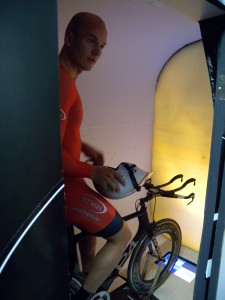
- Dean getting ready
Testing Protocol:
Dean and Marty tested about six positions each during the course of the sessions at a 5 degree yaw angle. Based on Dean’s past testing and representative real world wind conditions he sees on most TT courses the 5 degree yaw angle best represented the conditions we were seeking. Each position test included 4 separate 30-second runs, and the CdAs from each of those 4 runs were averaged to give you the final CdA for that position. Accuracy and precision were taken seriously as the wind tunnel drag measuring equipment was checked and calibrated before each run.
Athlete’s Starting Equipment and Kit:
Dean: Cervelo P4, HED Integrated aero bars, long sleeve Champion Systems speed suit, aero booties, Louis Garneau Rocket TT helmet, Zipp ZedTech 1080 front and rear 900 disk, no hydration on the bike except the integrated P4 water bottle.
Marty: Parlee TT bike, Zipp Integrated Vuka Bar, Champion Systems Tri Top and Tri bottom, Louis Garneau Rocket TT helmet, Zipp 808 front and rear 900 disk, no hydration on the bike.
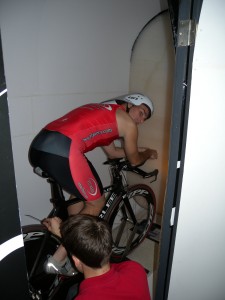
- Setting Marty up for his first run
Testing and Results:
Over the years Dean has refined his position and equipment selection through hundreds of hours of field testing. As record holder of numerous local time trials and triathlon bike courses, his testing results and very aerodynamic position have propelled him to many impressive finishes. If any significant improvement was gained as a result of this testing session we would be happy.
Starting Position:
Dean: Reported CdA values tend to vary from wind tunnel to wind tunnel due to a variety of factors we won’t get into regarding air boundary layer control, air speed measurement, and drag measuring technology. CdA is also impacted by yaw angle, whether or not the rider is pedaling and wheels rotating. For the purpose of this visit it’s not the exact CdA value that matters, but the relative changes to this value that matter. Dean tested his CdA in field testing in the 0.22-0.23 range out of the wind tunnel. The first run resulted in a CdA of 0.240, so we felt we were in range.
Marty: Current CdA had not been accurately determined with field testing, but we’ve estimated his CdA at 0.250 based on race results, and training rides given his body size, equipment, and power output. Starting position resulted in a 0.261 CdA.
Position #2:
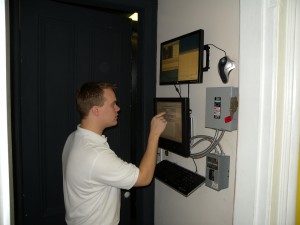
- Crunching numbers
Dean:
Helmet Change: Dean switched from the LG Rocket to the LG Superleggera. The Superleggera is the newest version of the Rocket helmet, but has dimples over the top and larger vents in the front. The best TT helmet for a rider tends to be very individual and this was certainly the case for Dean.The Superleggera was clearly faster than the Rocket for him so he kept this on for the rest of the tests: Result = Faster: CdA 0.236
Marty:
Drop: We moved Marty 2 cm lower which resulted in the same 0.261 CdA. If anything the lower position could have proved less comfortable or resulted in some power loss from closing him off too much at the top of the pedal stroke. Since there weren’t any benefits we moved him back to the starting position and moved on to Helmets.
Position #3:
Dean:
Drop: We dropped the front end 2cm lower than his current field tested position. The result was the same CdA, so there was no reason to run any more drop than he currently had. Dean had already tested this in the field and did not see a benefit, but wanted to try it under wind tunnel conditions. Result = Same: CdA 0.236
Marty:
LAS Crono TT Helmet: In Marty’s case the LAS Crono proved slightly faster than the LG Rocket.Equipment can be very individual and this proved the case here. Result = Faster: CdA 0.256
Position #4:
Dean:
Drop again: We raised the front end 2cm higher than the baseline (4cm higher than position #3). We only did 2 data runs because this position was clearly slower, so we didn’t waste any more time. Our conclusion was that he must have passed a critical point where his head was just getting too high in the wind and drag went up quickly. Result = Slower: CdA 0.260
Marty:
Spiuk Kronos Time Trial Helmet: Big gains made with the Kronos. Marty’s starting CdA was 0.261 and the Kronos brought this down to 0.246. Significant savings on paper!
Position #5:
Dean:
Horizontal Water Bottle mounted between the aerobars:We went back to the baseline drop and then added the water bottle between his forearms. Dean ran this system during Timberman and while it felt different he wanted to know the actual difference.
Cervelo tested something similar in the wind tunnel and said it reduced drag, but this definitely depends on the individual setup, and likely yaw angle as well. Result = Slightly slower than fastest run: CdA. 0.239
Marty:
Reach: Marty realized during races that when he held the end of his aero extensions that his head dropped and he felt just as relaxed and powerful. We’d experimented with this in the shop and noticed not only did his head get lower, but his shoulders narrowed a bit with the longer reach. The wind tunnel confirmed our suspicions as the resulting drag reduction was notable. Marty’s CdA dropped all the way to 0.237 and we knew that Marty had refined his riding technique enough in the past few years to the point that he could maintain this longer position comfortably.
Position #6:
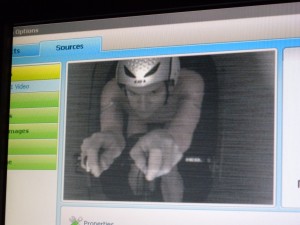
- A view from inside the tunnel
Dean:
Aerobar Angle – We tilted Dean’s Hed aerobars up just slightly – about 5 degrees. He’d tested this in the field without seeing any gains, but had made some other position changes since then. Dean noticed that a slight amount of tilt leveled off the tops of his forearms, lowered his head and shoulders slightly, and was more comfortable. As he settled into the position he figured that if he got the same CdA then he would run this position since it was more comfortable. We were all pretty excited during the first run because there was quite a reduction in drag. After 4 runs including a re-check of the calibration we confirmed a faster and more comfortable position. Result = Fastest: CdA 0.229
Marty:
We tested his aero pads closer together, and it actually increased his CdA to 0.244. We went back to his original pad width and tried tilting the aerobar extensions up 5 degrees just like Dean’s. The upward extension tilt actually increased Marty’s CdA, despite helping Dean lower his, which supports our experiences that aerobar tilt/angle gains tend to be individual.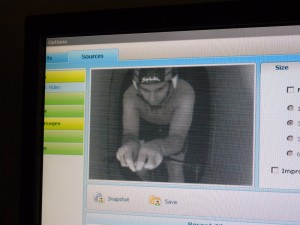
Final Analysis:
As bike fitting experts we expected our starting positions to be fast, but looked forward to searching out any potential gains in equipment and fine tuning our positions. In Dean’s case the only two things that helped make him faster were the helmet change and the aerobar extension tilt. In Marty’s case a different helmet change and slightly longer reach made significant improvements.
Dean lowered his CdA from 0.240 to 0.229 which at his race power and speed is worth about 17 seconds in a 10-mile TT, 27 seconds in a 13-mile sprint bike leg, and about 1:40 in a typical HIM 56-mile bike leg.
Marty lowered his CdA from 0.261 to 0.237 which at his race power and speed is worth about 46 seconds in a 10-mile TT, 57 seconds in a 13-mile sprint bike leg, and about 4:16 in a HIM 56-mile bike leg.
Take Home Message:
The trip to the tunnel was a blast and the sessions are best used to refine your position and/or look into equipment options. We are excited to try out the tunnel results in 2010 and see how well they hold up in the real world.
Like previous trips to a wind tunnel, our recommendation that the athlete should go through the bike fitting process before heading to the wind tunnel was reinforced. Wind tunnel time goes by quickly and it is not cheap. It does not make any sense to use valuable tunnel time finding gains that are easily identified outside of the tunnel in the bike fitting process while also establishing the rider’s individual biomechanical range that they need to stay in if they are going to maintain power and comfort. By getting fit first, the athlete will be able to use most of his/her time refining details that can only be accomplished in the wind tunnel or carefully controlled field testing. If you have any questions or would like additional information on our fitting services please contact us directly.
Disclaimer: Our testing session at this wind tunnel was done at only one yaw angle, there wasn’t any pedaling, and the wheels weren’t turning. Actual CdA values for riders pedaling on moving bikes in a range of real world wind conditions may be slightly different but will be in the same ballpark. We are looking forward to racing in our new positions next season, and of course field testing things against them in our continuous quest to find faster positions and equipment for the athletes that work with us!

